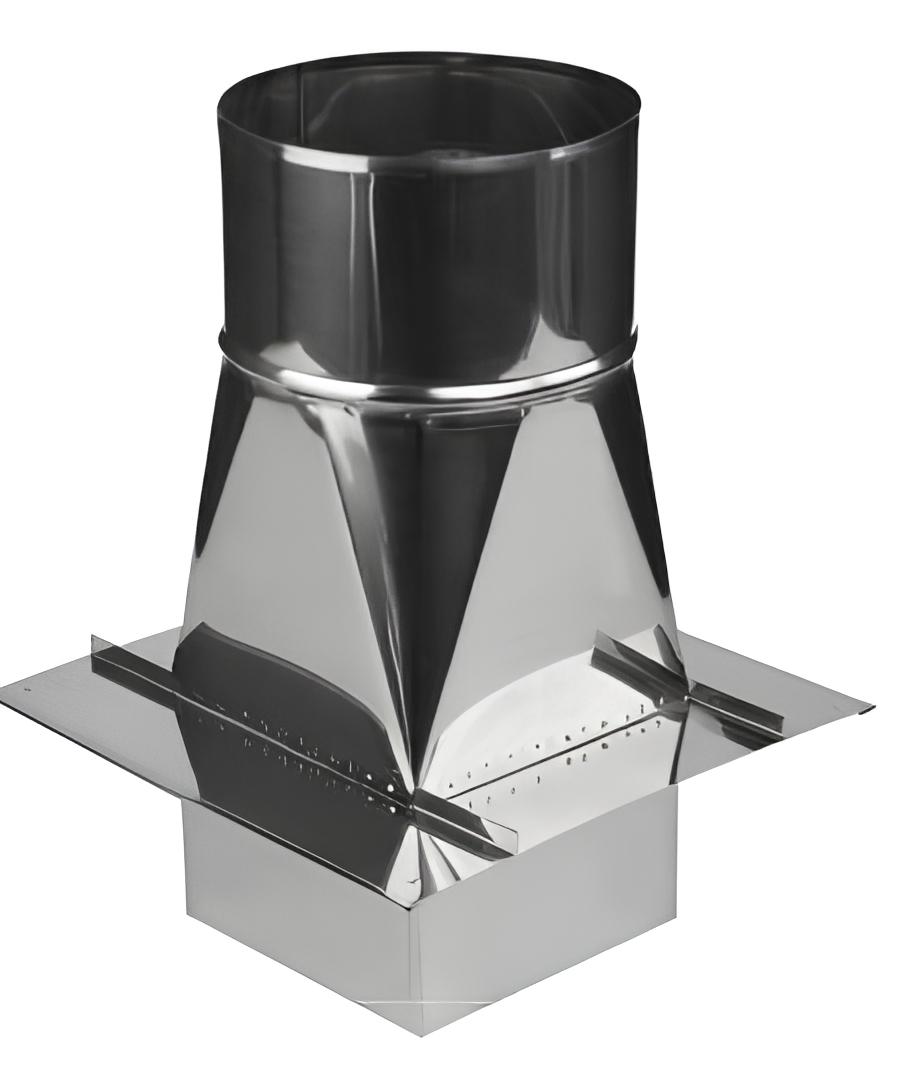| Installation BASES and adapters for cowls
Bases and Adapters: An Engineering Approach to Deflector Mounting

Bases and adapters are not just connecting elements, but critically important engineering components that directly determine the structural integrity, sealing, aerodynamic efficiency, and safety of the entire ventilation or chimney system. An error in the selection or manufacturing of these components can lead to reduced performance, leaks, or even create a fire hazard.
A properly designed mounting assembly performs four key tasks:
- Structural Reliability: It withstands the weight of the deflector, wind, and snow loads, maintaining its geometry and structural integrity.
- Sealing: It prevents precipitation from entering the duct and, in chimney systems, leakage of aggressive condensate and hazardous flue gases.
- Aerodynamic Efficiency: It provides a smooth transition between system elements, minimizing air flow resistance and reducing the load on ventilation equipment.
- Fire Safety: For chimneys, only heat-resistant materials are used, and the design complies with the strict requirements of the EN 1856-1 standard.
Key Differences: Requirements for Ventilation and Chimney Components
The most important aspect when choosing a base or adapter is the system's purpose. Mounting components for ventilation and chimneys operate under completely different conditions, which is why they are subject to fundamentally different requirements for materials, design, and standards.
-
For Ventilation
Task: To ensure effective air exchange, protect against precipitation, and resist corrosion.
- Operating Conditions: Indoor or outdoor air temperature, atmospheric precipitation.
- Governing Standard: EN 13141-1 (evaluates aerodynamic performance).
- Materials: Galvanized steel (standard solution), aluminum (for lightweight structures and humid climates), stainless steel (for aggressive environments, e.g., restaurant kitchens).
- Design: The main focus is on geometric precision to minimize air flow resistance (Local Resistance Coefficient) and ensure a watertight seal against rain.
-
For Chimney
Task: To guarantee stable draft, withstand high temperatures and aggressive condensate, and ensure fire safety.
- Operating Conditions: Hot, chemically aggressive flue gases, acidic condensate.
- Governing Standard: EN 1856-1 (evaluates safety, heat resistance, and acid resistance).
- Materials: Only heat-resistant and acid-resistant stainless steel with a thickness of at least 0.6 mm. The use of galvanized steel or aluminum is strictly prohibited.
- Design: Sealing against flue gas leakage is as critical as sealing against precipitation. Dimensional accuracy (a tolerance of ±5 mm on the diameter) and the quality of welded seams are of paramount importance.
Design Solutions and Their Tasks
Depending on the duct diameter and operating conditions, different types of bases and adapters are used.
Bases for Deflectors: Strength and Stability
The base serves as a load-bearing platform. The key parameter here is the steel thickness, which is selected based on diameter and wind loads.
- Standard Thickness (0.5 - 0.7 mm): Suitable for most residential systems with duct diameters up to 800 mm.
- Increased Thickness (1.0 - 1.4 mm): Mandatory for large-diameter systems (900 mm and above), where wind loads and the risk of deformation are significantly higher.
- Flanged Bases: The industrial standard, ensuring maximum sealing and serviceability through a bolted connection.
Adapters/Transitions: Aerodynamics and Efficiency
Adapters are used for a smooth connection between a round deflector and square or rectangular shafts. Their main task is to minimize the Local Resistance Coefficient. Sharp transitions create turbulence, "brake" the air flow, increase noise, and force the fan to consume more electricity. We design adapters with optimal geometry to ensure your system operates efficiently and economically.
Installation: From Components to Professional Fitting
Where to install? Bases and adapters are part of the deflector's mounting assembly, which is installed at the highest point of the vertical duct — at the end of the ventilation shaft or chimney on the building's roof.
Everything for installation: For reliable mounting on ducts and shafts of any cross-section (round, rectangular, square), we produce all types of transitions and adapters. We will select or manufacture components specifically for your system.
Professional installation: If you want to guarantee a perfect result, SIA "Akvilon" offers professional installation services. Our in-house specialists ensure the correct installation of all components, proper sealing of connections, and commissioning to guarantee the design efficiency and durability of the entire system.

CE Certification and Compliance
All system components supplied by Akvilon are CE marked, confirming their full compliance with EU regulations and harmonized standards such as EN 1856-1 and EN 12237.
Have questions? You can find answers to frequently asked questions in our FAQ section.
Procurement and Design
Our engineers are ready to help equip the system for your project. When standard solutions are not suitable due to unique dimensions or offset axes, we offer a service for manufacturing custom adapters and transitions from your drawings. This is not just metal bending, but a complete engineering service: we design the component for minimal aerodynamic resistance, ensuring the long-term efficiency of your system. You can also purchase all standard components in our online store.
| |
|
|